
Wetenschap
Een toonaangevende theorie voor de kwantumoorsprong van bewustzijn samenvouwen

Het Gran Sasso-laboratorium voor lage radioactiviteit. Krediet:Massimiliano De Deo, LNGS-INFN
De oorsprong van bewustzijn is een van de grootste mysteries van de wetenschap. Een voorgestelde oplossing, voor het eerst voorgesteld door de Nobelprijswinnaar en de wiskundige Roger Penrose uit Oxford en de anesthesist Stuart Hammeroff van de Universiteit van Arizona in Tucson, schrijft bewustzijn toe aan kwantumberekeningen in de hersenen. Dit hangt op zijn beurt af van het idee dat zwaartekracht een rol zou kunnen spelen in hoe kwantumeffecten verdwijnen of 'instorten'. Maar een reeks experimenten in een laboratorium diep onder het Gran Sasso-gebergte, in Italië, heeft geen bewijs gevonden ter ondersteuning van een zwaartekrachtgerelateerd model voor kwantuminstorting, waardoor de haalbaarheid van deze verklaring voor bewustzijn wordt ondermijnd. Het resultaat wordt gerapporteerd in het tijdschrift Physics of Life Reviews .
"Hoe bewustzijn ontstaat in de hersenen is een enorme puzzel", zegt Catalina Curceanu, een lid van de denktank voor fysica, het Foundational Questions Institute, FQXi, en de hoofdfysicus van de experimenten bij INFN in Frascati, Italië. "Er zijn veel concurrerende ideeën, maar slechts weinigen kunnen experimenteel worden getest."
De kwantumfysica vertelt ons beroemd dat katten tegelijkertijd levend en dood kunnen zijn, althans in theorie. Maar in de praktijk zien we katten nooit opgesloten in zo'n ongelukkige limbo-staat. Een populaire verklaring voor waarom niet is dat de "golffunctie" van een systeem - het kwantumkarakter waardoor het zich tegelijkertijd in twee tegenstrijdige toestanden bevindt - waarschijnlijker zal "instorten" of vernietigd worden als het massiever is, waardoor het in één gedefinieerde toestand blijft. staat, ofwel dood of levend, laten we zeggen, maar niet allebei tegelijk. Dit model van ineenstorting, gerelateerd aan zwaartekracht die inwerkt op zware objecten zoals katten, werd in de jaren negentig door Penrose en Hammeroff ingeroepen bij het ontwikkelen van hun bewustzijnsmodel, 'Orch OR-theorie' (de Orchestrated Objective Reduction-theorie).
Kwantumberekeningen in de hersenen
Curceanu raakte voor het eerst geïnteresseerd in Orch OR-theorie toen ze Penrose, ook een FQXi-lid, enkele jaren geleden ontmoette op een conferentie. Bewustzijn wordt meestal niet geassocieerd met kwantumeigenschappen omdat kwantumeffecten fragiel en moeilijk te handhaven zijn, zelfs onder sterk gecontroleerde omstandigheden en koude temperaturen in het laboratorium. Dus werd lang aangenomen dat de warme en natte omgeving van de hersenen te storend zou zijn om kwantumeffecten te laten overleven. Maar Penrose legde uit dat hij en Hammeroff kleine structuren hebben geïdentificeerd die microtubuli worden genoemd in neuronen in de hersenen en die mogelijk kwantumeffecten voor korte perioden zouden kunnen ondersteunen - net lang genoeg om kwantumberekeningen uit te voeren. Orch OR-theorie schrijft bewustzijn toe aan kwantumberekeningen die worden georkestreerd ("Orch") door elektrische oscillaties in deze microtubuli. "Wat ik geweldig vond aan deze theorie was dat deze in principe toetsbaar is en ik besloot te zoeken naar bewijs dat zou kunnen helpen deze te bevestigen of te vervalsen", zegt Curceanu.
"Wat ik geweldig vond aan deze theorie was dat het in principe toetsbaar is en ik besloot te zoeken naar bewijs dat zou kunnen helpen om het te bevestigen of te vervalsen."
De kern van de theorie is het idee dat zwaartekracht gerelateerd is aan de ineenstorting van de kwantumgolffunctie en dat deze ineenstorting sneller is in systemen met meer massa. Dit concept is in de jaren tachtig door verschillende natuurkundigen in een aantal modellen ontwikkeld. One of those was Lajos Diósi, at the Wigner Research Center for Physics and at the Eötvös Loránd University in Budapest, Hungary, who has co-authored the new paper with Curceanu, Maaneli Derakhshani of Rutgers University in New Brunswick, New Jersey, Matthias Laubenstein also at INFN, and Kristian Piscicchia of CREF and INFN. Penrose independently approached this idea a few years later and it became the core of his consciousness theory with Hammeroff.
The two theories are often referred to by the umbrella term, the "Diósi-Penrose theory." But behind the joint name there is an important difference, notes Curceanu. Diósi's approach predicts that collapse would be accompanied by the spontaneous emission of a small amount of radiation, just large enough to be detected by cutting edge experiments.
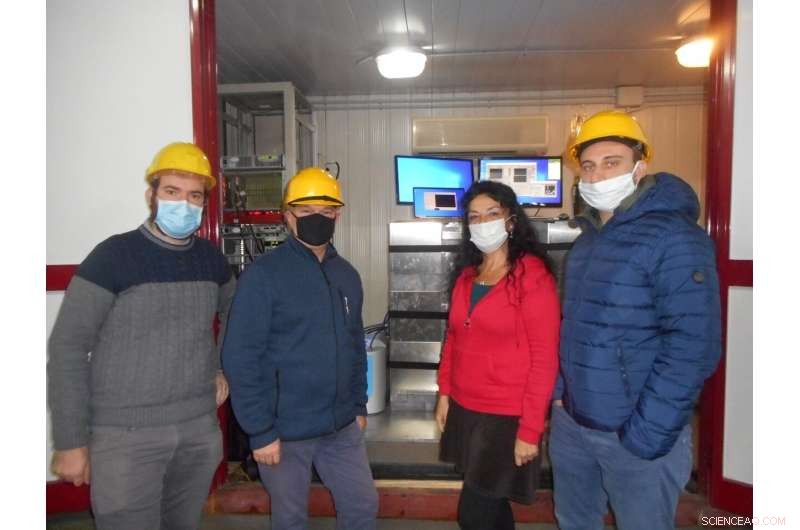
Left to right:Fabrizio Napolitano, Alberto Clozza, Catalina Curceanu, Marco Miliucci -- all from INFN-LNF. Credit:Catalina Curceanu
Going underground
Curceanu's underground lab is housed within the Gran Sasso National Laboratory, 1.4 km under the Gran Sasso Italian mountains. The lab stands on one side of the 10-km long highway tunnel which crosses the Gran Sasso massif, connecting L'Aquila and Teramo. "The location was chosen because it is basically free from cosmic-ray radiation sources above the ground, that could interfere with the experiment," says Curceanu. The experiment uses an extremely sensitive cylindrical detector, not much bigger than a mug, made from highly pure germanium. It is surrounded by shielding, made of layers of ultra-pure lead and copper, to shelter it from any background radiation coming from the rocks. After running the experiment for two months the team did not measure spontaneous radiation signals, constraining the feasibility of gravity-related collapse. In 2020, the team reported in Nature Physics that their negative result had helped them rule out the simplest version of the Diósi-Penrose model.
In their new paper they have explicitly examined the repercussions of their finding for Penrose and Hammeroff's Orch OR theory of consciousness. After reanalyzing the most plausible scenarios set out by Hammeroff and Penrose, in light of their recent experimental constraints on quantum collapse, they were led to conclude that almost none of the scenarios are plausible. "This is the first experimental investigation of the gravity-related quantum collapse pillar of the Orch OR consciousness model, which we hope will be followed by many others," says Curceanu. "I am very proud of our achievement."
Interdisciplinary characteristics
The experiments and analysis are partially funded by a grant from the Foundational Questions Institute, FQXi. "Without it, it would have not been possible to achieve this outcome," says Curceanu. "It is hard to otherwise get funding for projects such as this, based on its interdisciplinary characteristics."
"It is really exciting to connect what you can do in the laboratory to perhaps the biggest mystery in the universe—consciousness."
But all is not lost for Orch Or, adds Curceanu. "Actually, the real work is just at the beginning." she says. In fact, Penrose's original collapse model, unlike Diósi's, did not predict spontaneous radiation, so has not been ruled out. The new paper also briefly discusses how a gravity-related collapse model might realistically be modified. "Such a revised model, which we are working on within the FQXi financed project, could leave the door open for Orch OR theory," Curceanu says.
Meanwhile the team is preparing to test these refined new collapse models, to further investigate their implications for the Orch OR model. "It is really exciting to connect what you can do in the laboratory to perhaps the biggest mystery in the universe—consciousness," says Curceanu. + Verder verkennen
Deconstructing Schrödinger's cat
 Oude eiwitten bieden aanwijzingen voor het verleden
Oude eiwitten bieden aanwijzingen voor het verleden Röntgenanalyse onthult het oplaadmechanisme van een veelbelovend elektrodemateriaal
Röntgenanalyse onthult het oplaadmechanisme van een veelbelovend elektrodemateriaal Video:Hoe dubbelwerkend bakpoeder twee keer werkt
Video:Hoe dubbelwerkend bakpoeder twee keer werkt Vergelijking tussen metaal- en ionenkristallen
Vergelijking tussen metaal- en ionenkristallen Nieuwe elektrokatalysator ontwikkeld voor opwaardering van biomassa en waterstofopwekking
Nieuwe elektrokatalysator ontwikkeld voor opwaardering van biomassa en waterstofopwekking
 Grote vulkaanuitbarstingen in de tropen kunnen El Nino-gebeurtenissen veroorzaken
Grote vulkaanuitbarstingen in de tropen kunnen El Nino-gebeurtenissen veroorzaken NASA ziet een georganiseerde orkaan Helene in de buurt van Afrika
NASA ziet een georganiseerde orkaan Helene in de buurt van Afrika Nieuwe studie onderzoekt de oorzaken en gevolgen van de overstromingen in Wimberley in 2015
Nieuwe studie onderzoekt de oorzaken en gevolgen van de overstromingen in Wimberley in 2015 Video:plasticvervuiling in de oceaan vanuit de ruimte in de gaten houden
Video:plasticvervuiling in de oceaan vanuit de ruimte in de gaten houden Een groot deel van het zuidwesten van de VS is uitgedroogd na het moessonseizoen
Een groot deel van het zuidwesten van de VS is uitgedroogd na het moessonseizoen
Hoofdlijnen
- Van wondgenezing tot regeneratie
- Bacteriën hebben tastzin
- Antidepressiva uit urine maken vissen minder bang voor roofdieren
- Verschil tussen bacterie- en plantencel Wall
- Termieten houden van het broeikaseffect, het tempo van hun houtkauwen wordt aanzienlijk sneller bij warmer weer
- Chemische stoffen gebruikt in de forensische wetenschap
- Nieuwe filmtechniek onthult bacteriële signalering in scherpere resolutie
- Welke organel moet aanwezig zijn in grote aantallen in spiercellen?
- Hoe herstelt de huid?
- Holografische histopathologie maakt snelle, nauwkeurige diagnose
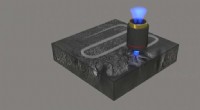
- Waarom een druppel olie stuitert in een water/ethanol gradiënt en uiteindelijk op de bodem van een pot valt?
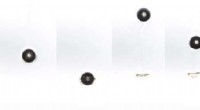
- Arapuca-apparaat voor internationaal neutrino-experiment is verbeterd
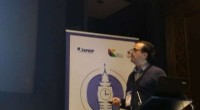
- Doeloefening:het productiedoel van Mu2e perfectioneren
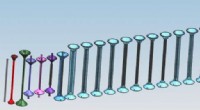
- Onderzoek naar de cruciale overdrachtsprocessen en dynamiek van ladingsdragers binnen perovskiet actieve lagen
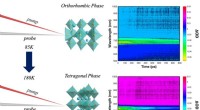
 Femtoseconde laserfabricage - het realiseren van dynamische controle van elektronen
Femtoseconde laserfabricage - het realiseren van dynamische controle van elektronen Onderzoekers nemen de temperatuur van moleculen op
Onderzoekers nemen de temperatuur van moleculen op Doorbraak gemeld in door machine learning verbeterde kwantumchemie
Doorbraak gemeld in door machine learning verbeterde kwantumchemie Trio wint Nobelprijs Economie voor werk aan armoede
Trio wint Nobelprijs Economie voor werk aan armoede Hoe de diameter van een rechthoek
Hoe de diameter van een rechthoek Een beenprothese met gevoel verbetert de mobiliteit
Een beenprothese met gevoel verbetert de mobiliteit Soorten verbranding
Soorten verbranding Fotonica:grafeen versterkt on-chip lichtdetectoren
Fotonica:grafeen versterkt on-chip lichtdetectoren
- Elektronica
- Biologie
- Zonsverduistering
- Wiskunde
- French | Italian | Spanish | Portuguese | Swedish | German | Dutch | Danish | Norway |

-
Wetenschap © https://nl.scienceaq.com

